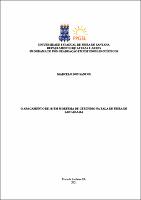| ???jsp.display-item.social.title??? |


|
Please use this identifier to cite or link to this item:
http://tede2.uefs.br:8080/handle/tede/1407Full metadata record
| DC Field | Value | Language |
|---|---|---|
| dc.creator | Santos, Marcelo dos | - |
| dc.creator.Lattes | http://lattes.cnpq.br/0729115354142639 | por |
| dc.contributor.advisor1 | Oliveira, Josane Moreira de | - |
| dc.contributor.advisor1Lattes | http://lattes.cnpq.br/3819920117221086 | por |
| dc.contributor.advisor-co1 | Gayer, Juliana Escalier Ludwig | - |
| dc.contributor.advisor-co1Lattes | http://lattes.cnpq.br/4359632184480241 | por |
| dc.date.accessioned | 2022-11-01T14:13:29Z | - |
| dc.date.issued | 2021-03-31 | - |
| dc.identifier.citation | SANTOS, Marcelo dos. O apagamento de /d/ em morfema de gerúndio na fala de Feira de Santana-Ba. 2021. 117 f. Dissertação (Mestrado Acadêmico em Estudos Linguísticos) - Departamento de Letras e Artes, Universidade Estadual de Feira de Santana, Feira de Santana, 2021 | por |
| dc.identifier.uri | http://tede2.uefs.br:8080/handle/tede/1407 | - |
| dc.description.resumo | Esta dissertação apresenta os resultados de uma pesquisa sobre o apagamento da oclusiva /d/ no morfema –ndo, indicador de gerúndio, no português brasileiro. Assume-se que o fenômeno pesquisado é uma regra de natureza variável em que a variável dependente binária se caracteriza pela manutenção ou apagamento de /d/ no morfema de gerúndio como em cantando (forma padrão) e cantano (forma não-padrão). O referencial teórico-metodológico é o da Sociolinguística Variacionista (WEINREICH; LABOV; HERZOG, 2006 [1968]; LABOV, 2008 [1972]). O estudo foi realizado a partir de 24 entrevistas sociolinguísticas da cidade de Feira de Santana-BA, oriundas do banco de dados do projeto “A Língua Portuguesa no Semiárido Baiano” (UEFS). O objetivo da pesquisa foi descrever como o fenômeno está condicionado de acordo com fatores estruturais e sociais, bem como observar, em tempo aparente, se há indícios de mudança linguística em curso na comunidade pesquisada. Foram controladas as variáveis sociais ‘escolaridade’, ‘sexo’ e ‘faixa etária’, e as variáveis linguísticas ‘conjugação verbal’, ‘extensão do verbo’, ‘contexto seguinte’ e ‘estrutura sintática’. Os dados foram analisados quantitativamente por meio da ferramenta computacional GoldVarb X (SANKOFF; TAGLIAMONTE; SMITH, 2005). Os resultados indicam taxa de uso de 67,7% de aplicação da variante não-padrão no corpus. O fenômeno variável é condicionado por fatores linguísticos e extralinguísticos, sendo que foram estatisticamente relevantes, nesta ordem de seleção, as variáveis ‘escolaridade’, ‘sexo’, ‘contexto seguinte’, ‘faixa etária’ e ‘extensão do verbo’. | por |
| dc.description.abstract | This dissertation presents results of a research about the deletion of the stop /d/ in the morpheme –ndo, indicator of gerund, in Brazilian Portuguese. It is assumed that the researched phenomenon is a rule of variable nature in which the binary dependent variable is characterized by the maintenance or deletion of /d/ in the morpheme of gerund as in cantando (standard form) and cantano(non-standard form). The theoretical-methodological framework is the Variationist Sociolinguistics (WEINREICH; LABOV; HERZOG, 2006 [1968]; LABOV, 2008 [1972]). The study was carried out based on 24 sociolinguistic interviews from the city of Feira de Santana-BA, selected from the database of the project “A Língua Portuguesa no Semiárido Baiano”(UEFS). The objective of the research is to describe how the phenomenon is conditioned according to structural and social factors, as well as to observe, in apparent time, if there are signs of linguistic change taking place in the researched community. The social variables controlled were ‘education’, ‘sex’ and ‘age group’, and the linguistic variables were ‘verbal conjugation’, ‘verb length’, ‘following context’ and ‘syntactic structure’. The data were analyzed quantitatively using the computational tool GoldVarb X (SANKOFF; TAGLIAMONTE; SMITH, 2005). The results indicate usage rate of 67.7% of the non-standard variant in the corpus. The variable phenomenon is conditioned by linguistic and extralinguistic factors and the variables ‘education’, ‘sex’, ‘following context’, ‘age group’ and ‘verb length’ were statistically relevant in this order of selection. | eng |
| dc.description.provenance | Submitted by Renata Aline Souza Silva (rassilva@uefs.br) on 2022-11-01T14:13:29Z No. of bitstreams: 1 Dissertação_Marcelo dos Santos_2021.pdf: 4782973 bytes, checksum: 1b96341fb9a9c910f7eda935ec093b5e (MD5) | eng |
| dc.description.provenance | Made available in DSpace on 2022-11-01T14:13:29Z (GMT). No. of bitstreams: 1 Dissertação_Marcelo dos Santos_2021.pdf: 4782973 bytes, checksum: 1b96341fb9a9c910f7eda935ec093b5e (MD5) Previous issue date: 2021-03-31 | eng |
| dc.format | application/pdf | * |
| dc.thumbnail.url | http://tede2.uefs.br:8080/retrieve/6816/Disserta%c3%a7%c3%a3o_Marcelo%20dos%20Santos_2021.pdf.jpg | * |
| dc.language | por | por |
| dc.publisher | Universidade Estadual de Feira de Santana | por |
| dc.publisher.department | DEPARTAMENTO DE LETRAS E ARTES | por |
| dc.publisher.country | Brasil | por |
| dc.publisher.initials | UEFS | por |
| dc.publisher.program | Mestrado Acadêmico em Estudos Linguísticos | por |
| dc.rights | Acesso Aberto | por |
| dc.subject | Gerúndio | por |
| dc.subject | Sociolinguística | por |
| dc.subject | Variação e mudança linguística | por |
| dc.subject | Apagamento de /d/ | por |
| dc.subject | Feira de Santana | por |
| dc.subject | Gerund | eng |
| dc.subject | Sociolinguistics | eng |
| dc.subject | Linguistic variation and change | eng |
| dc.subject | Deletion of /d/ | por |
| dc.subject | Feira de Santana. | eng |
| dc.subject.cnpq | LINGUISTICA, LETRAS E ARTES | por |
| dc.subject.cnpq | LETRAS::LINGUA PORTUGUESA | por |
| dc.subject.cnpq | LINGUISTICA, LETRAS E ARTES::LETRAS | por |
| dc.title | O apagamento de /d/ em morfema de gerúndio na fala de Feira de Santana-Ba | por |
| dc.type | Dissertação | por |
| Appears in Collections: | Coleção UEFS | |
Files in This Item:
| File | Description | Size | Format | |
|---|---|---|---|---|
| Dissertação_Marcelo dos Santos_2021.pdf | Dissertação Marcelo dos Santos 2021 | 4.67 MB | Adobe PDF |  Download/Open Preview |
Items in DSpace are protected by copyright, with all rights reserved, unless otherwise indicated.




